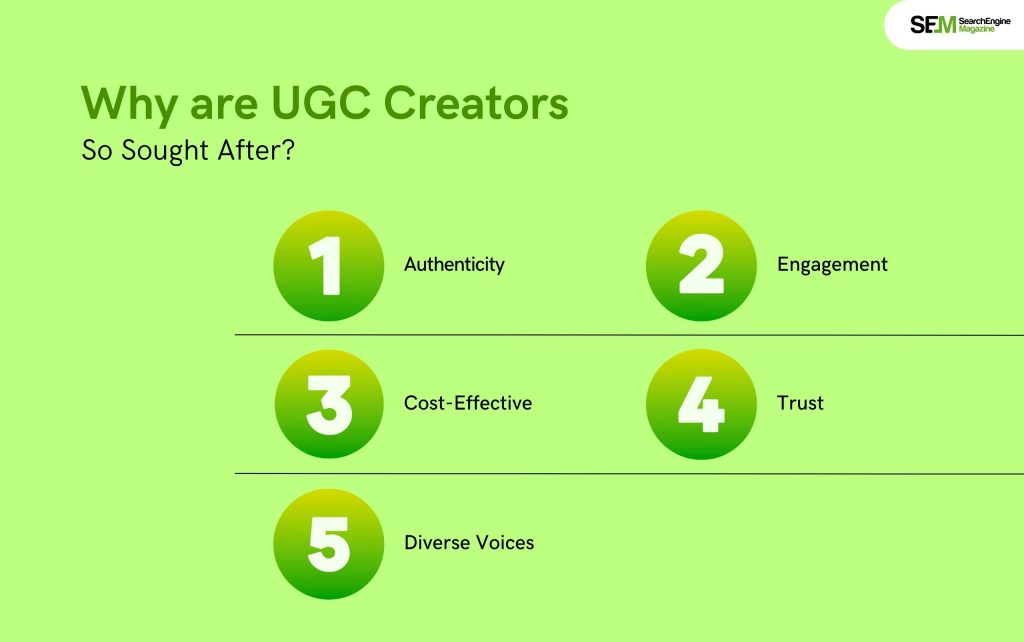Ahrefs Vs Semrush: Which Is The Better SEO Tool In 2025?
Apr 08, 2025

Apr 08, 2025

Mar 29, 2025

Mar 29, 2025

Mar 29, 2025

Mar 29, 2025

Mar 29, 2025

Mar 27, 2025

Mar 27, 2025
Sorry, but nothing matched your search "". Please try again with some different keywords.


User-generated content (UGC) has taken the digital world by storm in the last couple of years as one of the crucial elements of modern marketing strategies.
Most businesses are embracing more authentic and relatable content, hence the role of UGC creators in defining the stories of the brands.
What is a UGC creator? How do you become one? We will take a closer look at the new trend of creating UGC, what it takes to be successful as a UGC creator, and expert tips on how to make a career out of it.

Before discussing what a UGC creator does, let’s define User-Generated Content (UGC) clearly.
UGC refers to any content created by a consumer or user of a platform, such as images, videos, blog posts, reviews, or social media posts, not by the brands or businesses themselves.
Often, it shows honest opinions, experiences, or creative expressions that may be more relatable and authentic to audiences.
The deep engagement that can be achieved with UGC compared to traditional advertising is its power. Consumers believe their peers’ content is better than content written or published by brands. This is because most consumers consider it more authentic and less refined.
For this reason, companies have been increasingly using UGC to market their products, services, or ideas in ways that come across as genuine and honest.

A UGC creator creates content for brands or businesses from the perspective of a consumer or user. Unlike traditional influencers.
Who let their brand huck by using their personal content and high followers as part of their strategy, UGC creators focus on content applicable across various marketing campaigns.
All the above types – product reviews, tutorials, unboxing videos, photographs, and many more- can be created by UGC creators from the consumer’s point of view towards the brand or its products.
They work closely with brands in developing content that attracts the specific target market that will resonate well with the company’s messaging.
But it is designed to be much more relatable and engaging than something created strictly for the corporation from the point of view of the everyday consumer.

UGC creators have been in high demand lately for a couple of reasons. First, it was proved that UGC is more efficient than traditional advertising in terms of customer engagement and conversion.
A person is much more likely to believe content coming from an average user rather than content produced by brands themselves.
Here are some of the primary reasons UGC creators are in demand today.
It feels real, honest, not too polished, and scripted. What makes it all the more appealing to audiences is that it is far more relatable.
When consumers see a product being used or reviewed by another consumer who likes it, they become more likely to trust it.
Social media and all other online forums show greater involvement in using UGC. The audiences enjoy their spare time more with personal and truth-sounding content.
Brands may have to invest much more in a promotion made by a full-scale production team, but UGC is cost-effective.
Besides this, not all UGC creators are level-playing field production creators. Sometimes, the pen is mightier than the sword.
UGC is the most trusted source of advertisements. Consumer market research says a consumer trusts user-generated content more than that of a professional advertisement. This also helps the bonding between a consumer and brand become greater.
UGC can give brands diversified voices, which enables their marketing communications to become the most relevant to a diverse segment of customers.
For these reasons, UGC’s creators are very valuable and there is a growing opportunity for individuals to enter this stream of work.
Becoming a UGC creator in 2025 can be very lucrative as a side hustle or perhaps even a full-time business.
So, let’s break down the steps taken in creating that UGC creator career, finding your niche, and finally coming up with some content that will get noticed.
The first is to identify which brands you’d want to work with. This requires a lot of thinking and research.
First, pick topics, industries, or product categories you’re interested in. This might be in fashion, tech, fitness, beauty, home decor, or anything else that catches your fancy.
Being aligned to a niche you care about will make content creation fun and authentic. Remember to pick something exciting to you and in demand in the market.
Identify your audience. They can be other consumer communities or groups of people that share an interest in what concerns you.
What they want or need will define how you propose to write for them. Think about likes, comments, and patterns of engagements, and get ready to reply.
Once you’ve identified your niche and audience, research potential brands that would be a good fit. Look for brands that align with your values and content style.
Consider contacting smaller or emerging companies looking for cost-effective ways to market their products.
You work with brands of great repute that resonate within your heart. You must research their social presence, customer feedback, and other content to ensure they are an ideal fit. It is you working with reputable brands and maintaining your credibility as a UGC creator.
This will also be successful in the long run if it is done for long-term relations with brands. One needs to look for brands that are interested in long-term collaboration rather than just one-time projects. With them, one can grow and continuously evolve one’s content.
You’ll even start with just a few of your favorite brands, but you diversify the mix over time in your portfolio.
In this manner, you are not beholden to any one brand, but you still develop a comprehensive profile that can attract several potential customers.
Once you have identified your brands and niche, it is time to create content. This is where the magic happens; your content will speak for itself and showcase your skills.
Determine the type of content you would like to create. Whether it is photos, videos, tutorials, reviews, or unboxing, the type of content you make should align with your chosen niche. Your content should be original, consumable, and interesting.
Always consider your target audience while developing content. Learn what interests them, their pain points, and their preferences. Thus, you’ll address their needs, making the content effective.
Consistency is a good quality of a good UGC creator. Publishing once a week or once a month will leave an impression on your audience and the brand partners who believe in your consistency.
Then, engage with your followers through social media by commenting on their posts and replying to queries, which can, in fact, prove too deeply connect with the audience and eventually increase your exposure to a maximum level.
Be brave enough to experiment with form, style, or type. Track the performance of your content through principal metrics such as views, likes, shares, and engagement to better adjust and understand what works for you.
A strong portfolio is the best way to attract brands and collaborators. Your portfolio should showcase your skills, creativity, and ability to deliver quality content.
Your portfolio has to be the best of your work: high quality, interesting, and on brand. Mix between the type-videos, photos, blog posts, etc.-to show off your range.
A portfolio is a marketing tool. Use it to show potential clients and brands the type of work you can do. Make sure your portfolio is navigable and includes clear contact information.
As you work for more brands, make sure you tailor your portfolio to the type of work you do. If you specialize in a lot of product reviews, let them stand out.
If your creative video advertisements are your gold, then work on those the most. Tailoring the portfolio to the brand’s requirements will probably draw more attention.
Make sure to lay it out and present the work appropriately, professionally, and cleanly. This presentation always reflects the reality or consistency you can offer.
Don’t be afraid to ask for feedback from colleagues, mentors, or brands you’ve worked with. Use their input to improve your portfolio. Regularly update it with fresh content to keep it relevant and reflect your growing skills.
Here are some examples of UGC content that creators typically produce:
It will be an excellent opportunity for any content lover to become a successful UGC creator in 2025.
It includes finding your niche, building true relationships with the brands, consistently creating excellent content, and showing them off within a remarkable portfolio – everything that will make it a fulfilling career within this developing field.
This is an emerging demand, considering brands’ growing interest in more authentic ways of engaging with audiences.
In this regard, following this guide will help enough to put a person on the pathway to success as a 2025 successful UGC creator.
Nabamita Sinha loves to write about lifestyle and pop-culture. In her free time, she loves to watch movies and TV series and experiment with food. Her favorite niche topics are fashion, lifestyle, travel, and gossip content. Her style of writing is creative and quirky.
View all Posts
Ahrefs Vs Semrush: Which Is The Better SEO To...
Apr 08, 2025
How Data-Driven Hiring Reduces Costs and Impr...
Mar 29, 2025
Why Headless CMS Works Well for EdTech Startu...
Mar 29, 2025
Building Topical Authority to Excel in Search...
Mar 29, 2025
The Impact of Professional Recruitment Servic...
Mar 29, 2025

